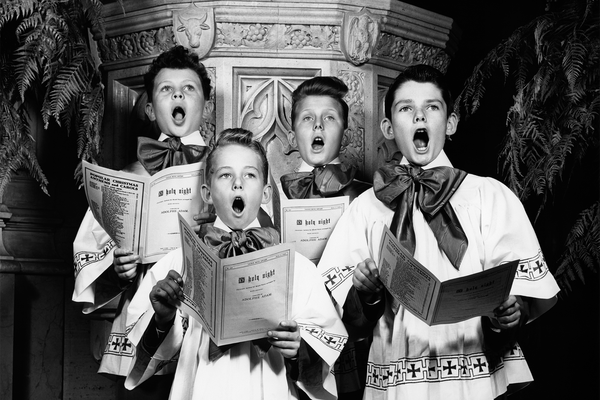It’s beginning to look a lot like Christmas, and if that phrase just put Bing Crosby on repeat in your brain, (A) sorry, and (B) you’re not alone.
’Tis the season, after all, to hear “Jingle Bells” and “Deck the Halls” everywhere, including inside your own head. Though there are no studies to quantify how often holiday tunes get stuck in people’s brain, anecdotal reports suggest that they are potent earworms—the term for a snippet of song that won’t stop echoing in your mind.
The science of earworms may point to some reasons that holiday music so easily gets stuck on repeat in people’s head. Though there’s no single recipe for an earworm, studies have shown that there are some commonalities.
On supporting science journalism
If you're enjoying this article, consider supporting our award-winning journalism by subscribing. By purchasing a subscription you are helping to ensure the future of impactful stories about the discoveries and ideas shaping our world today.
First, exposure: one of the largest studies ever conducted on earworms, a 2017 investigation in the journal Psychology of Aesthetics, Creativity, and the Arts, found that a song’s position on popular music charts and the recency of that position were both linked to its chances of being reported as an earworm. The data on songs, which were collected between 2009 and 2012, are a testimony to that finding. The songs that were most likely to be named as earworms in the study were likely to be playing on repeat at the time: “Bad Romance” by Lady Gaga, “California Gurls,” by Katy Perry and “Somebody That I Used to Know,” by Gotye were all on the list. Only three songs in the top nine—“Don’t Stop Believing,” by Journey, “Bohemian Rhapsody,” by Queen, and (fittingly) “Can’t Get You Out of My Head,” by Kylie Minogue—weren’t recent.
As any retail worker can attest, Christmas music is ubiquitous in December, meaning that a person’s exposure to it is high. “You have to listen to it often and maybe even hear it without listening to it consciously,” says Francesca Talamini, a postdoctoral researcher in psychology at the University of Innsbruck in Austria, who studies music and memory.
Then there’s the music itself. Research hasn’t always agreed on whether there is a particular type of music that’s likely to become an earworm, but it does seem that characteristics of singable tunes give songs a certain amount of stickiness. A small study presented at a 2012 conference found that songs commonly reported as earworms were more likely than equally popular nonearworm songs to have longer notes and shorter distances between pitches. This means that they were fairly easy to sing by nonprofessionals—think “favorite karaoke tunes.” The larger 2017 earworm study did not replicate that finding but did find that earworm songs were more likely than nonearworm ones to generally have features common to the average pop tune.
Holiday music, often written for religious services and group caroling, is designed to be simple and singable, Talamini says. “Simple structures are easier to perceive for our brain, and therefore, they are easier to memorize,” she says.
Music processing is a whole-brain activity that starts with the auditory cortex, a region of the cortex that sits approximately behind the ear and processes any kind of sound. Given the many factors that influence how a person perceives a single song—rhythm, pitch, lyrics, emotion, memory of the melody and any personal memories attached to the music—a wide variety of brain regions are soon roped in. For instance, according to a 2022 review paper in the journal Nature Reviews Neuroscience, brain regions associated with movement (motor areas) activate in response to the beat, while the inferior frontal gyrus in the prefrontal cortex may process some aspects of harmony and the order of the notes and rhythms. Lyrics are processed in language areas, while the emotions stirred up by music show up in the brain’s reward networks, activating regions such as the nucleus accumbens, a very basic structure that sits deep in the forebrain.
When people imagine music, these same regions activate, minus the auditory receptors, says Shihab Shamma, a professor of electrical and computer engineering at the University of Maryland. Humans may be quite unique in their ability to appreciate music, Shamma says.
On top of this fundamental appreciation for music, humans acculturate themselves to specific types of pitches and melodies. “When you grow up in a certain culture, you develop a model of music that is in your head and certain expectations of what music is,” Shamma says.
Holiday music, of course, carries a lot of cultural meaning—it’s tied into emotions and autobiographical memories of winter seasons past. One famous finding about music and other cultural activities, Shamma says, is that people like them best when they’re a little bit familiar and a little bit new. “The most enjoyment is when you’re in the middle between these,” he says.
If nothing else, this science may explain why there’s a seemingly endless appetite for new recordings of “Santa Claus Is Comin’ to Town,” “Jingle Bell Rock,” and “Let It Snow! Let It Snow! Let It Snow!”—and why these songs won’t likely leave your head until the new year rolls around.
